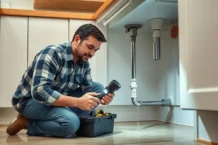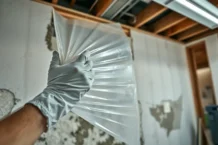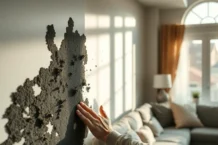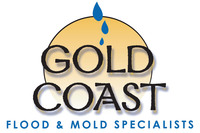Prevent Mold Growth – San Diego CA
Are you tired of dealing with mold growth in your home? It’s a common problem that can lead to health issues and property damage if left unchecked. But fear not—we have 7 effective ways to prevent mold growth and keep your home clean and safe.
First, ensure proper ventilation in your home. Mold thrives in damp and humid environments, so it’s important to keep the air flowing. Open windows, use fans, and install exhaust systems in high-moisture areas like bathrooms and kitchens.
Next, fix any leaks or water seepage immediately. Even small leaks can provide enough moisture for mold to grow. Inspect your home regularly for water damage signs and promptly address any issues.
Another crucial step is maintaining low indoor humidity. In areas with high moisture levels, use dehumidifiers to keep the humidity below 50%.
Don’t forget to clean and maintain your gutters regularly. Clogged gutters can lead to water buildup, increasing the risk of mold growth around your home’s foundation.
Proper ventilation of appliances, such as dryers or stoves, is also important. This prevents excess moisture from accumulating and reduces the risk of mold growth.
Regularly wash and thoroughly dry fabrics, such as curtains, towels, and carpets. Avoid leaving wet clothes or towels around, as they retain moisture and promote mold growth.
Lastly, check your indoor plants. Overwatered plants can create a breeding ground for mold, so ensure proper drainage and avoid excessive watering.
By following these 7 effective tips, you can greatly reduce the risk of mold growth in your home and enjoy a clean and healthy living environment.

Identifying the causes of mold growth
Understanding the underlying causes of mold growth is essential in developing an effective prevention strategy. Some of the most common culprits include:
- Leaks and water damage: Any water intrusion, whether from a leaky roof, plumbing issue, or flooding, can create the perfect environment for mold to thrive.
- High indoor humidity: Excess moisture in the air can lead to surface condensation, providing the moisture mold needs to grow.
- Poor ventilation: Inadequate airflow in the home can trap humidity and create stagnant, damp conditions that promote mold growth.
- Flooding or water damage: Significant water events, such as a flood or a burst pipe, can make it difficult to dry out moisture, leading to mold.
- Organic materials: Mold can feed on various organic materials, including wood, paper, and fabrics, providing a ready food source.
By identifying the specific factors contributing to mold growth in your home, you can take targeted steps to address the root causes and prevent future infestations. Regular inspections, proactive maintenance, and addressing any moisture-related issues are all critical in keeping mold at bay.
Effective ways to prevent mold growth
Preventing mold growth in your home requires a multifaceted approach. Here are seven effective ways to keep mold at bay:
Proper ventilation is one of the most important factors in preventing mold growth. Ensuring your home has adequate airflow can help remove excess moisture and prevent humidity buildup. This can be achieved by opening windows, using exhaust fans in bathrooms and kitchens, and installing whole-home ventilation systems. Additionally, maintaining indoor humidity levels below 50% can significantly reduce the risk of mold growth. Dehumidifiers, especially in damp or high-moisture areas, can help keep humidity in check.
Ensure your home’s drainage system directs water away from the foundation to prevent seepage into basements and crawl spaces.
Add mold inhibitors when painting your home, especially in areas prone to moisture. This can help prevent mold from developing on walls and ceilings.
Regularly cleaning and maintaining your home can go a long way in preventing mold growth. This includes:
- Cleaning and disinfecting bathrooms, kitchens, and other high-moisture areas routinely.
- Promptly addressing any spills or leaks to prevent water from accumulating.
- Keeping gutters and downspouts clear ensures proper drainage and prevents water buildup around the home’s foundation.
- Regularly inspecting and cleaning HVAC systems can harbor mold if improperly maintained.
- Regularly check for and address any signs of water damage or moisture problems.
By prioritizing cleaning and maintenance, you can create an environment that is less hospitable to mold growth.
Be mindful of indoor plants, as moist soil can be a breeding ground for mold. Avoid overwatering and use a natural antifungal treatment.
One of the most effective ways to prevent mold growth is to address any sources of water intrusion or moisture buildup in your home. This includes:
- Promptly repair leaks in the roof, walls, plumbing, or appliances.
- Addressing any areas of water damage, such as flooding or burst pipes, to ensure the area is properly dried and cleaned.
- They ensure your home’s foundation and basement are properly sealed and waterproofed to prevent moisture from seeping in.
- We are addressing issues with poor drainage or water pooling around the home’s exterior.
Eliminating the sources of moisture that mold needs to thrive can significantly reduce the risk of mold growth in your home.
Choosing mold-resistant materials can be a powerful preventive measure when it comes to home renovations or new construction. Some examples include:
- Mold-resistant drywall or sheetrock is designed to be more resistant to moisture and mold growth.
- Mold-resistant paints and sealants that can be applied to walls, floors, and other surfaces.
- Mold-resistant insulation, which can help control humidity and prevent moisture buildup.
- Mold-resistant flooring materials, such as tile or vinyl, are less susceptible to water damage and mold growth.
By incorporating these mold-resistant materials into your home, you can create an environment less conducive to mold growth, even in high-moisture areas.

Conclusion: Taking proactive measures to prevent mold growth
Mold growth in the home can be a serious and persistent problem, with far-reaching consequences for your health and your home’s structural integrity. However, by taking a proactive and multi-faceted approach to prevention, you can effectively mitigate the risk of mold and enjoy a clean, safe, and healthy living environment.
The key is addressing the underlying causes of mold growth, such as moisture, poor ventilation, and water damage while incorporating mold-resistant materials and practices into your home maintenance routine. By following the strategies outlined in this article, you can significantly reduce the risk of mold growth and safeguard your home and family from its potential dangers.
Remember, the best way to deal with mold is to prevent it from taking hold in the first place. Stay vigilant, address any issues promptly, and take proactive steps to create a mold-resistant home. You can enjoy a clean, healthy, and mold-free living environment for years with the right approach.









Follow Us!